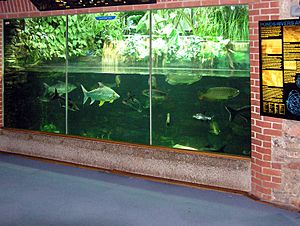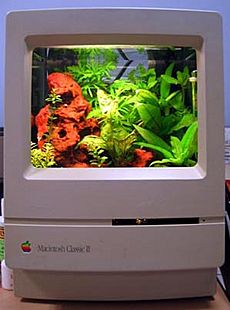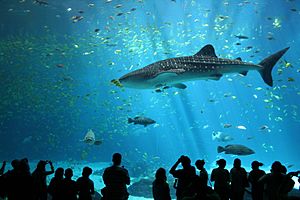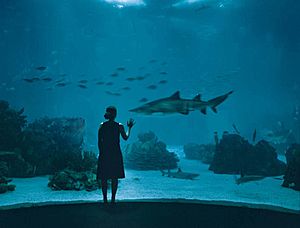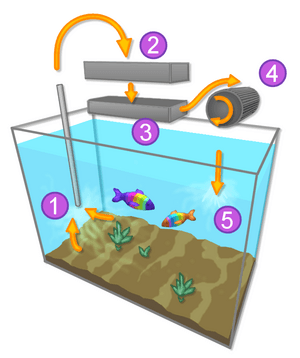Aquarium facts for kids
An aquarium (plural aquariums or aquaria) is a place where fish and other animals that live in water are kept by humans. An aquarium can be a small tank, or a large building with one or more large tanks.
Keeping an aquarium is a popular hobby around the world. Careful aquarists (people who keeps aquariums) make sure their fish live in an environment similar to their natural habitats. This means caring about water quality, lighting, and food.
Large public aquariums are often popular with tourists. They show the fish and other animals they keep in large tanks, and also often protect species that are close to extinction. An example of a public aquarium is Sydney Aquarium, Sydney, New South Wales, Australia.
Contents
Design
Materials
Most aquaria consist of glass panes bonded together by silicone, with plastic frames that are attached to the upper and lower edges for decoration. The glass aquarium is standard for sizes up to about 1000 litres (250 gal). However, glass as a material is brittle and has very little give before fracturing, though generally the sealant fails first. Aquaria come in a variety of shapes such as cuboid, hexagonal, angled to fit in a corner (L-shaped), and bow-front (the front side curves outwards). Fish bowls are generally either made of plastic or glass, and are either spherical or some other round configuration in shape.
The very first modern aquarium made of glass was developed in the 19th century by Robert Warrington. During the Victorian age it was common for glass aquaria to have slate or steel bottoms, which allowed the aquaria to be heated underneath with an open flame heat source. The aquaria in those days had the glass panels attached with metal frames and sealed with putty. These metal framed aquaria were still available on the market until the mid 1960s when the modern, silicone-sealed style replaced them. Acrylic tanks were not generally available to the public until the 1970s.
Although glass aquaria are usually preferred by aquarists over the acrylic ones because of their resistance to scratching and much more accessible price, they come with several disadvantages. Not only are they not as crack resistant as acrylic tanks but they are also nearly two times heavier than the latter. They also provide less insulation than acrylic aquaria and do not come in as many interesting shapes as these do. Many aquarists or beginners who want to get fish as pets find it particularly onerous that many online suppliers will not ship glass aquaria because of the high potential for cracking and the high weight, which increases the cost of shipping. However, glass tanks are more convenient for other aquarists because unlike acrylic, glass does not yellow over time, and also because glass tanks do not need as much support as acrylic aquaria.
Even though the price is one of the main considerations for aquarists when deciding which of these two types of aquaria to purchase, when it comes to very large tanks the price difference tends to disappear.
Acrylic aquaria are also available and are the primary competitor with glass. Acrylic aquaria are stronger than glass, and much lighter. Acrylic-soluble cements are used to directly fuse acrylic together (as opposed to simply sealing the seam). Acrylic allows for the formation of unusual shapes, such as the hexagonal tank. Compared to glass, acrylics are easy to scratch; but unlike glass, it is possible to polish out scratches in acrylic.
Laminated glass is sometimes used, which combines the advantages of both glass and acrylic.
Large aquaria might instead use stronger materials such as fiberglass-reinforced plastics. However, this material is not transparent. Reinforced concrete is used for aquaria where weight and space are not factors. Concrete must be coated with a waterproof layer to prevent the water from breaking down the concrete as well as preventing contamination by the concrete.
Styles
Aquariums have been fashioned into coffee tables, sinks, and even toilets. Another such example is the MacQuarium, an aquarium made from the shell of an Apple Macintosh computer. Some new aquariums provide space inside for an air-breathing pet such as a cat, bird or hamster. In recent years, elaborate custom-designed home aquariums costing hundreds of thousands of dollars have become status symbols—according to The New York Times, "among people of means, a dazzling aquarium is one of the last surefire ways to impress their peers."
A kreisel tank is a circular aquarium designed to hold delicate animals such as jellyfish. These aquariums provide slow, circular water flow with a bare minimum of interior hardware, to prevent delicate animals from becoming injured by pumps or the tank itself. Originally a German design (kreisel means spinning top), the tank has no sharp corners, and keeps the housed animals away from the plumbing. Water moving into the tank gives a gentle flow that keeps the inhabitants suspended, and water leaving the tank is covered by a delicate screen that prevents the inhabitants from getting stuck. There are several types of kreisel tanks. In a true kreisel, a circular tank has a circular, submerged lid. Pseudokreisels have a curved bottom surface and a flat top surface, similar to the shape of either a "U" or a semicircle. Stretch kreisels or Langmuir kreisels are a "double gyre" kreisel design, where the tank length is at least twice the height. Using two downwelling inlets on both sides of the tank lets gravity create two gyres in the tank. A single downwelling inlet may be used in the middle as well. The top of a stretch kreisel may be open or closed with a lid. There may also be screens about midway down the sides of the tank, or at the top on the sides. It is possible to combine these designs; a circular shaped tank is used without a lid or cover, and the surface of the water acts as the continuation of circular flow. It is now possible to start a jellyfish aquarium at home as easily as a regular fish tank.
Another popular setup is the biotope aquarium. A biotope aquarium is a recreation of a specific natural environment. Some of the most popular biotopes (to name only a few) are the Amazon river, Rio Negro River, Lake Malawi, Lake Tanganyika, and Lake Victoria. The fish, plants, substrate, rocks, wood, and any other component of the display should match that of the natural environment. It can be a real challenge to recreate such environments and most "true" biotopes will only have a few species of fish (if not only one) and invertebrates.
Aquarium size and volume
An aquarium can range from a small glass bowl containing less than a litre (34 fl.oz.) of water to immense public aquaria that house entire ecosystems such as kelp forests. Relatively large home aquaria resist rapid fluctuations of temperature and pH, allowing for greater system stability.
Unfiltered bowl-shaped aquaria are now widely regarded as unsuitable for most fish. Advanced alternatives are now available. Aquariums should contain three forms of filtration: biological, mechanical and chemical to keep water conditions at suitable levels.
Reef aquaria under 100 litres (20 gal) have a special place in the aquarium hobby; these aquaria, termed nano reefs (when used in reefkeeping), have a small water volume.
Practical limitations, most notably the weight (one litre of fresh water has a mass of 1 kilogram (8.3 lb gal−1), and salt water is even denser) and internal water pressure (requiring thick glass siding) of a large aquarium, keep most home aquaria to a maximum of around 1 cubic metre in volume (1,000 kg or 2,200 lb). Some aquarists, however, have constructed aquaria of many thousands of litres.
Public aquariums designed for exhibition of large species or environments can be dramatically larger than any home aquarium. The Georgia Aquarium, for example, features an individual aquarium of 6,300,000 US gallons (24,000 m3).
Components
The typical hobbyist aquarium includes a filtration system, an artificial lighting system, and a heater or chiller depending on the aquarium's inhabitants. Many aquaria incorporate a hood, to decrease evaporation and prevent fish from leaving the aquarium (and anything else from entering the aquarium). They also often hold lights.
Combined biological and mechanical aquarium filtration systems are common. These either convert ammonia to nitrate (removing nitrogen at the expense of aquatic plants), or to sometimes remove phosphate. Filter media can house microbes that mediate nitrification. Filtration systems are the most complex component of home aquaria.
Aquarium heaters combine a heating element with a thermostat, allowing the aquarist to regulate water temperature at a level above that of the surrounding air, whereas coolers and chillers (refrigeration devices) are for use anywhere, such as cold water aquaria, where the ambient room temperature is above the desired tank temperature. Thermometers used include glass alcohol thermometers, adhesive external plastic strip thermometers, and battery-powered LCD thermometers. In addition, some aquarists use air pumps attached to airstones or water pumps to increase water circulation and supply adequate gas exchange at the water surface. Wave-making devices have also been constructed to provide wave action.
An aquarium's physical characteristics form another aspect of aquarium design. Size, lighting conditions, density of floating and rooted plants, placement of bog-wood, creation of caves or overhangs, type of substrate, and other factors (including an aquarium's positioning within a room) can all affect the behavior and survival of tank inhabitants.
An aquarium can be placed on an aquarium stand. Because of the weight of the aquarium, a stand must be strong as well as level. A tank that is not level may distort, leak, or crack. These are often built with cabinets to allow storage, available in many styles to match room decor. Simple metal tank stands are also available. Most aquaria should be placed on polystyrene to cushion any irregularities on the underlying surface or the bottom of the tank itself. However, some tanks have an underframe making this unnecessary.
Aquarium maintenance

Large volumes of water enable more stability in a tank by diluting effects from death or contamination events that push an aquarium away from equilibrium. The bigger the tank, the easier such a systemic shock is to absorb, because the effects of that event are diluted. For example, the death of the only fish in a three U.S. gallon tank (11 L) causes dramatic changes in the system, while the death of that same fish in a 100 U.S. gallon (400 L) tank with many other fish in it represents only a minor change. For this reason, hobbyists often favor larger tanks, as they require less attention.
Several nutrient cycles are important in the aquarium. Dissolved oxygen enters the system at the surface water-air interface or via an air pump. Carbon dioxide escapes the system into the air. The phosphate cycle is an important, although often overlooked, nutrient cycle. Sulfur, iron, and micronutrients also cycle through the system, entering as food and exiting as waste. Appropriate handling of the nitrogen cycle, along with supplying an adequately balanced food supply and considered biological loading, is enough to keep these other nutrient cycles in approximate equilibrium.
An aquarium must be maintained regularly to ensure that the fish are kept healthy. Daily maintenance consists of checking the fish for signs of stress and disease, on a daily basis.
Water conditions
The solute content of water is perhaps the most important aspect of water conditions, as total dissolved solids and other constituents dramatically impact basic water chemistry, and therefore how organisms interact with their environment. Salt content, or salinity, is the most basic measure of water conditions. An aquarium may have freshwater (salinity below 500 parts per million), simulating a lake or river environment; brackish water (a salt level of 500 to 30,000 PPM), simulating environments lying between fresh and salt, such as estuaries; and salt water or seawater (a salt level of 30,000 to 40,000 PPM), simulating an ocean environment. Rarely, higher salt concentrations are maintained in specialized tanks for raising brine organisms.
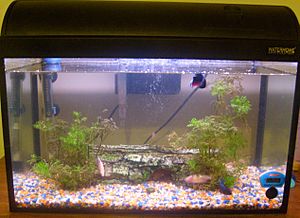
Home aquarists typically use tap water supplied through their local water supply network to fill their tanks. Straight tap water cannot be used in countries that pipe chlorinated water. In the past, it was possible to "condition" the water by simply letting the water stand for a day or two, which allows the chlorine time to dissipate. However, chloramine is now used more often and does not leave the water as readily. Additives formulated to remove chlorine or chloramine are often all that is needed to make the water ready for aquarium use. Brackish or saltwater aquaria require the addition of a commercially available mixture of salts and other minerals.
Water temperature determines the two most basic aquarium classifications: tropical vs. cold water. Most fish and plant species tolerate only a limited temperature range: Tropical aquaria, with an average temperature of about 25 °C (77 °F), are much more common. Cold water aquaria are for fish that are better suited to a cooler environment. More important than the range is consistency; most organisms are not accustomed to sudden changes in temperatures, which can cause shock and lead to disease. Water temperature can be regulated with a thermostat and heater (or cooler).
Nitrogen cycle

Of primary concern to the aquarist is management of the waste produced by an aquarium's inhabitants. Fish, invertebrates, fungi, and some bacteria excrete nitrogen waste in the form of ammonia (which converts to ammonium, in acidic water) and must then pass through the nitrogen cycle. Ammonia is also produced through the decomposition of plant and animal matter, including fecal matter and other detritus. Nitrogen waste products become toxic to fish and other aquarium inhabitants at high concentrations.
The process
A well-balanced tank contains organisms that are able to metabolize the waste products of other aquarium residents. This process is known in the aquarium hobby as the nitrogen cycle.
Bacteria known as nitrifiers (genus Nitrosomonas) metabolize nitrogen waste. Nitrifying bacteria capture ammonia from the water and metabolize it to produce nitrite. Nitrite is toxic to fish in high concentrations.
In addition to bacteria, aquatic plants also eliminate nitrogen waste by metabolizing ammonia and nitrate. When plants metabolize nitrogen compounds, they remove nitrogen from the water by using it to build biomass that decays more slowly than ammonia-driven plankton already dissolved in the water.
Aquarium supplies
A way to keep the aquarium clean and fresh is by using specific aquarium cleaning supplies. These may include cleaning agents especially designed to clean the water and keep it fresh, nets, algae magnets and scrapers, algae pads, brushes, gravel cleaners, sealant and tongs and grabbers. A properly cleaned aquarium means healthy and happy fish. Aquarium cleaning must be performed on a regular basis to ensure that the fish are healthy. Also, by maintaining a clean aquarium one makes sure the tank looks appealing to the visitors.
Water clarifiers are used to clean up the water that might get foamy or cloudy due to chemicals or biological blooms. Overfeeding or fish death can lead to a sudden increase in organic waste which may result in biological clouding. Water clarifiers are useful in these cases. However, they should not be needed too often because excessive clouding can mean that the filters or filter media are not working properly and should be changed.
Excessive algae and cyanobacteria can be removed with the help of algaecides.
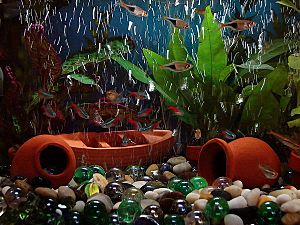
Other factors affecting capacity
One variable is differences between fish. Smaller fish consume more oxygen per gram of body weight than larger fish. Labyrinth fish can breathe atmospheric oxygen and do not need as much surface area (however, some of these fish are territorial, and do not appreciate crowding). Barbs also require more surface area than tetras of comparable size.
Oxygen exchange at the surface is an important constraint, and thus the surface area of the aquarium matters. Some aquarists claim that a deeper aquarium holds no more fish than a shallower aquarium with the same surface area. The capacity can be improved by surface movement and water circulation such as through aeration, which not only improves oxygen exchange, but also waste decomposition rates.
Waste density is another variable. Decomposition in solution consumes oxygen. Oxygen dissolves less readily in warmer water; this is a double-edged sword since warmer temperatures make fish more active, so they consume more oxygen.
Public aquaria

Most public aquarium facilities feature a number of smaller aquaria, as well those too large for home aquarists. The largest tanks hold millions of gallons of water and can house large species, including sharks or beluga whales. Dolphinaria are specifically for dolphins. Aquatic and semiaquatic animals, including otters and penguins, may also be kept by public aquaria. Public aquaria may also be included in larger establishments such as a marine mammal park or a marine park.
Virtual aquariums
A virtual aquarium is a computer program which uses 3D graphics to reproduce an aquarium on a personal computer. The swimming fish are rendered in real time, while the background of the tank is usually static.
Images for kids
-
The underwater tunnel in the London aquarium
-
An aquarium of the 1850s containing Vallisneria spiralis and coldwater fish from Shirley Hibberd's The Books of the Aquariums and Waters Cabinets. London
-
The Jardin zoologique at the Bois de Boulogne included an aquarium that housed both fresh and saltwater animals, 1860 in Paris.
-
Pike in an aquarium c. 1908, at the Belle Isle Aquarium, Belle Isle Park
-
An aquarium in the Burj Al Arab in Dubai
-
Live plants in an aquarium utilize the final product in the nitrogen cycle of nitrate as fertilizer, helping the nitrate levels stay minimal. This 60-litre aquarium contains Anubias barteri and Echinodorus bleheri. A heater and small filter are in the background.
-
A saltwater aquarium
See also
 In Spanish: Acuario (recipiente) para niños
In Spanish: Acuario (recipiente) para niños


